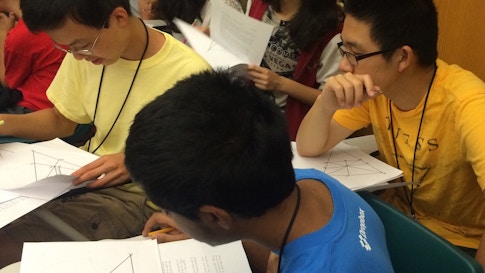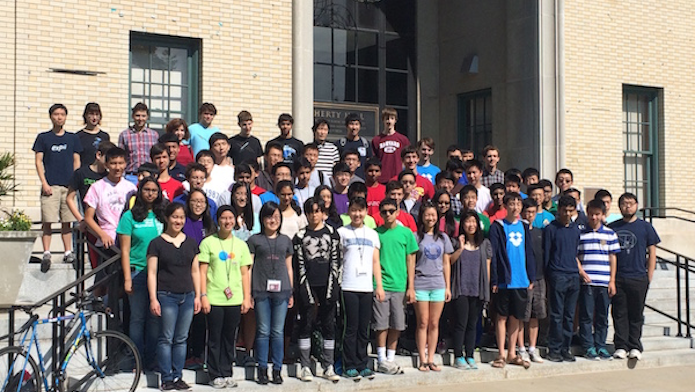Math Boot Camp Prepares U.S. Team for International Mathematical Olympiad

UPDATE (7/14/2015): This morning, scorers announced that the U.S. team has finished first in the International Mathematical Olympiad in Thailand.
PITTSBURGH—When it comes to their activities outside the classroom, the students at this summer camp are not very different from other teens. Some of them are on the debate team or play the piano. Others like to swim, toss around a Frisbee, or shoot hoops. Many are obsessed with video games and “Harry Potter.” But this summer, math has brought them together. For three weeks in June, these 54 students were part of an intensive camp designed to prepare them for the International Mathematical Olympiad in Thailand, which runs from July 4 to 16.
Founded in 1974 to train the first U.S. team, the Mathematical Olympiad Summer Program, known to participants as MOP, is one of the most selective high school math camps in the country. Students are chosen from the very top scorers in math contests including the USA Mathematical Olympiad and the Junior Mathematical Olympiad. Despite all this competition, the atmosphere of the camp is collegial and cooperative. “That’s something I tell them on day one of orientation,” MOP director Po-Shen Loh says. “The competition is over. We’re all here.”
Loh is a mathematician at Carnegie Mellon University, which is hosting the camp this year. He is also a camp alumnus. “My own history of being involved in the Mathematical Olympiad at this level is a whole bunch of serendipitous coincidences,” he says. In 1998, when he was a junior in high school, he gave a talk to his fellow campers on the last day of class. The handout he prepared, which he keeps on his website, says, “This is probably going to be my final lecture at MOP.” But he was wrong; the next year, he was back at the camp shortly before going to Romania to represent the U.S. at the International Mathematical Olympiad. Two years later, when the Olympiad was held in the U.S., he went to Washington, D.C., to be a tour guide for the Singapore team.
Since 2002, he has advanced from grader to camp instructor to assistant director and finally, about two years ago, to director of the program. “I like it because it’s a way of giving back to an organization and activity that I think contributed a lot to my own growth,” he says.
Although preparing for the Olympiad is MOP’s stated mission, neither contestants nor instructors see the competition as the finish line. Loh and the other instructors try not to teach techniques in isolation but to connect them with ideas that students will see later in their mathematical careers. “The focus of our program should be to recognize that we have 54 of the most impactful high school students in terms of potential, and we should help them be successful long-term,” Loh says. “That’s the goal.”
A grant from the Akamai Foundation has allowed the program to grow, enabling it to accept younger students, including some in junior high. Now the program tries to bring in 60 participants a year, about double the number from 10 years ago. But Loh sees it growing even more. “There’s a lot of energy, there’s a lot of value, and I think we could scale this into a program that could help more people.”
Loh, like many “MOPpers,” credits the middle school math competition Mathcounts for his interest in math. He says programs like Mathcounts and the Olympiad help bridge the gap between the kinds of problems most kids see on their high school math homework and real math research. High school problems are supposed to take minutes, whereas a mathematician can spend years on one research problem. “The Olympiad provides a good midstep in between, where you’re expected to think about it for five hours and still not solve it,” he says. “The jump from the five-minute problem to the five-hour problem is enormous.”
The Olympiad is the pinnacle of high school math contests worldwide. Many successful mathematicians, including the Fields medalists Maryam Mirzakhani and Terence Tao, competed as students. Each participating country sends a team of up to six students who individually take a six-question test over the course of two days, with students getting 4½ hours to answer three questions each day. Problems are worth seven points each, and a country’s score is the sum of the individual team members’ scores.
Olympiad questions generally fall into four categories: algebra, geometry, number theory and combinatorics. Although knowing calculus or other higher-level math subjects can be helpful, questions are designed to require creative problem solving rather than advanced techniques. Yang Liu, a returning member of the U.S. team, remembers question five from last year’s Olympiad, which was held in South Africa:

“That one took me a long time,” he says. “You just have to try a lot of random stuff, and eventually something works.” (Answers to all of last year’s problems are here.) His teammate Shyam Narayanan adds: “The main purpose of the Olympiad is not to test somebody’s knowledge, it’s to test your ability to solve problems with the knowledge you have.”
The first Olympiad, held in Romania in 1959, included only Eastern bloc countries of the cold war. But the event has grown tremendously since then: 101 teams competed in 2014. The last time the U.S. ranked first was in 1994, when all six team members got perfect scores, a feat never achieved by any other team. These days, China dominates the competition, having won about two-thirds of the Olympiads in the past 30 years, but the U.S. consistently sends one of the best teams, usually placing in the top three.
That consistency owes a great deal to MOP, where students spend much of their day figuring out how and when to apply newly learned techniques. Michael Kural, who is on this year’s U.S. team, describes these techniques as an “arsenal of weapons to use against problems.” The more weapons in your arsenal, the better your chances. “If you have a ton of techniques and each of them has a probability of working, then eventually something will work,” he says. “Probably.”

The U.S. squad has two Olympiad veterans this year: Both Allen Liu and Yang Liu competed last year. They laugh when asked if they have any sage advice for the rest of the team. “The most important thing is to remain calm and not let other things mess with your head during the test,” Allen Liu says. Easier said than done. “I was pretty excited at first, but then I realized I had a lot of work to do,” Narayanan says. “I’m under pressure.”
After three weeks of training, the six students, which include Ryan Alweiss and David Stoner, are ready for Thailand. The others, including some who might be on next year’s team, will be going home and getting on with their summer.
To cap their time together, on the last day of MOP the students got together to put on a talent show. Some of the acts — a song from Les Misérables, a not-quite-successful card trick — would have been at home in any high school talent show. A few, however, were unique to this environment, such as an onstage attempt by several students to write a computer program while holding a plank position on their elbows and toes. They may be some of the brightest young mathematicians in the country, but at that moment they were simply teenagers laughing together and getting ready to say goodbye to friends.
The Simons Foundation is a supporter of the Mathematical Olympiad Summer Program.


